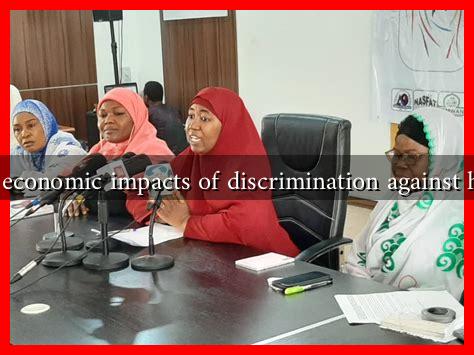-
Table of Contents
The Economic Impacts of Discrimination Against Hijab Wearers
Discrimination against hijab wearers is a pressing issue that extends beyond social and cultural realms, significantly impacting economic opportunities and outcomes for individuals and communities. This article explores the multifaceted economic consequences of such discrimination, highlighting the challenges faced by hijab wearers in various sectors, including employment, education, and entrepreneurship.
Understanding Discrimination Against Hijab Wearers
Discrimination against hijab wearers often manifests in various forms, including bias in hiring practices, workplace harassment, and social exclusion. This discrimination can stem from stereotypes, misconceptions about Islam, and a lack of understanding of cultural diversity. The economic implications of such discrimination are profound, affecting not only the individuals directly involved but also the broader economy.
Impact on Employment Opportunities
One of the most significant economic impacts of discrimination against hijab wearers is the limitation of employment opportunities. Studies have shown that individuals who wear hijabs often face barriers in the job market, leading to:
- Higher Unemployment Rates: Research indicates that Muslim women who wear hijabs experience higher unemployment rates compared to their non-hijab-wearing counterparts. A study by the Institute for Social Policy and Understanding found that Muslim women in the U.S. are 20% less likely to be employed than their non-Muslim peers.
- Wage Disparities: Even when hijab wearers secure employment, they often face wage disparities. A report by the European Network Against Racism highlighted that Muslim women in Europe earn significantly less than their non-Muslim colleagues, primarily due to discrimination in hiring and promotion practices.
- Limited Career Advancement: Discrimination can hinder career progression for hijab wearers, as they may be overlooked for promotions or leadership roles due to biases held by employers and colleagues.
Effects on Education and Skill Development
Discrimination also extends to educational institutions, where hijab wearers may face bullying or exclusion. This can lead to:
- Lower Educational Attainment: Discrimination in schools can result in lower academic performance and higher dropout rates among hijab-wearing students. A study published in the Journal of Educational Psychology found that Muslim girls who wear hijabs often report feeling marginalized in educational settings.
- Reduced Access to Resources: Hijab wearers may have limited access to mentorship and networking opportunities, which are crucial for skill development and career advancement.
Entrepreneurship Challenges
For many hijab wearers, entrepreneurship represents a viable path to economic independence. However, discrimination can create significant barriers, including:
- Access to Funding: Studies show that minority entrepreneurs, including hijab wearers, often face challenges in securing funding. A report by the Kauffman Foundation found that minority-owned businesses are less likely to receive venture capital compared to their white counterparts.
- Market Acceptance: Hijab-wearing entrepreneurs may struggle to gain acceptance in certain markets, limiting their customer base and growth potential.
Case Studies and Real-World Examples
Several case studies illustrate the economic impacts of discrimination against hijab wearers:
- France’s Burqa Ban: In 2010, France implemented a ban on full-face veils, which led to increased discrimination against Muslim women. A report by the Pew Research Center noted that this ban negatively affected the employment prospects of hijab wearers, contributing to economic marginalization.
- Canada’s Employment Equity Act: In contrast, Canada has implemented policies aimed at promoting diversity and inclusion in the workplace. These efforts have led to improved employment outcomes for hijab wearers, demonstrating the positive economic impact of inclusive policies.
Conclusion
The economic impacts of discrimination against hijab wearers are profound and far-reaching. From limited employment opportunities and wage disparities to challenges in education and entrepreneurship, the consequences of such discrimination extend beyond individual experiences to affect entire communities and economies. Addressing these issues requires a concerted effort from policymakers, employers, and society at large to foster inclusivity and equality. By recognizing and combating discrimination, we can unlock the full potential of hijab wearers, contributing to a more diverse and prosperous economy.
For further reading on the economic impacts of discrimination, you can explore resources from the Pew Research Center and the Kauffman Foundation.

